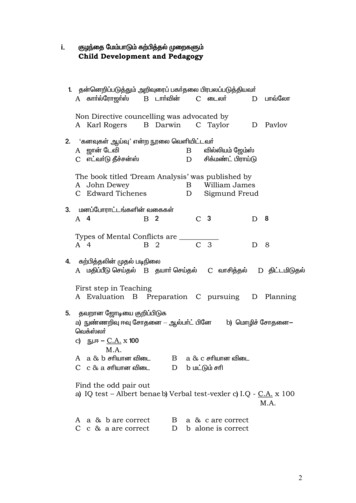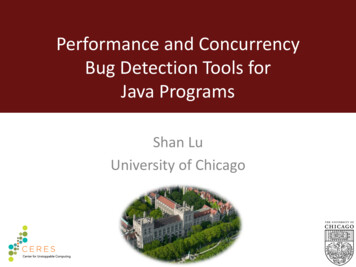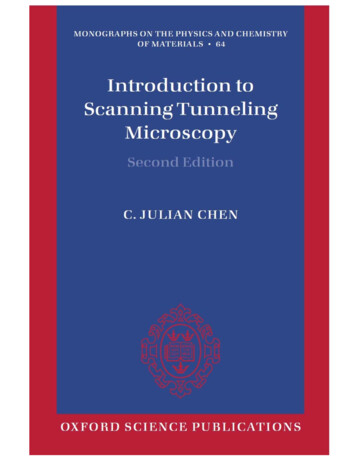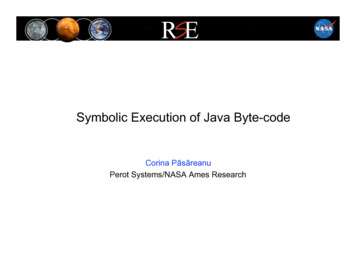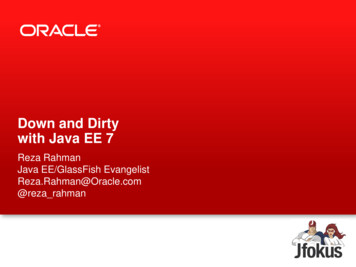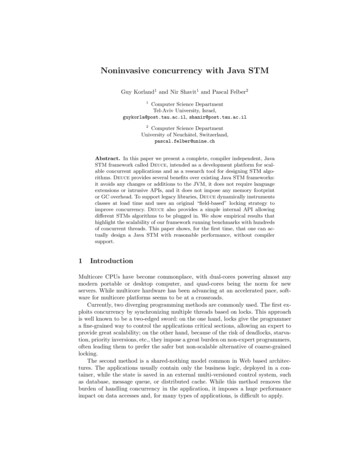
Transcription
Noninvasive concurrency with Java STMGuy Korland1 and Nir Shavit1 and Pascal Felber21Computer Science DepartmentTel-Aviv University, Israel,guykorla@post.tau.ac.il, shanir@post.tau.ac.il2Computer Science DepartmentUniversity of Neuchâtel, Switzerland,pascal.felber@unine.chAbstract. In this paper we present a complete, compiler independent, JavaSTM framework called Deuce, intended as a development platform for scalable concurrent applications and as a research tool for designing STM algorithms. Deuce provides several benefits over existing Java STM frameworks:it avoids any changes or additions to the JVM, it does not require languageextensions or intrusive APIs, and it does not impose any memory footprintor GC overhead. To support legacy libraries, Deuce dynamically instrumentsclasses at load time and uses an original “field-based” locking strategy toimprove concurrency. Deuce also provides a simple internal API allowingdifferent STMs algorithms to be plugged in. We show empirical results thathighlight the scalability of our framework running benchmarks with hundredsof concurrent threads. This paper shows, for the first time, that one can actually design a Java STM with reasonable performance, without compilersupport.1IntroductionMulticore CPUs have become commonplace, with dual-cores powering almost anymodern portable or desktop computer, and quad-cores being the norm for newservers. While multicore hardware has been advancing at an accelerated pace, software for multicore platforms seems to be at a crossroads.Currently, two diverging programming methods are commonly used. The first exploits concurrency by synchronizing multiple threads based on locks. This approachis well known to be a two-edged sword: on the one hand, locks give the programmera fine-grained way to control the applications critical sections, allowing an expert toprovide great scalability; on the other hand, because of the risk of deadlocks, starvation, priority inversions, etc., they impose a great burden on non-expert programmers,often leading them to prefer the safer but non-scalable alternative of coarse-grainedlocking.The second method is a shared-nothing model common in Web based architectures. The applications usually contain only the business logic, deployed in a container, while the state is saved in an external multi-versioned control system, suchas database, message queue, or distributed cache. While this method removes theburden of handling concurrency in the application, it imposes a huge performanceimpact on data accesses and, for many types of applications, is difficult to apply.
The hope is that transactional memory (TM) [11] will simplify concurrent programming by combining the desirable features of both methods, providing state-awareshared memory with simple concurrency control.In the past several years there has been a flurry of design and implementationwork on the software transactional memory (STM) [21]. However, the state of theart today is less than appealing. With the notable exception of transactional C/C compilers [15], most STM initiatives have remained academic experiments, applicableonly to “toy applications”, and though we have learned much from the process of developing them, they have not reached a state that will allow them to be seriously fieldtested. There are several reasons for this. Among them are the problematic handlingof many features of the target language, the large performance overheads, and thelack of support for legacy libraries. Moreover, many of the published results have beenbased on prototypes whose source code is unavailable or poorly maintained, makinga reliable comparison between the various algorithms and designs very difficult.In this paper, we introduce Deuce, our novel open-source Java framework fortransactional memory. Deuce has several desired features not found in earlier JavaSTM frameworks. As we discuss in Section 2, there currently does not exist an efficient Java STM framework that delivers a full set of features and can be added toan existing application without changes to its compiler or libraries. It was not clearif one could build such an an efficient “compiler independent” Java STM.Deuce is intended to fill this gap. It is non-intrusive in the sense that no modifications to the Java virtual machine (JVM) or extensions to the language are necessary.It uses, by default, an original locking design that detects conflicts at the level of individual fields without a significant increase in the memory footprint (no extra datais added to any of the classes) and therefore there is no GC overhead. This lockingscheme provides finer granularity and better parallelism than former object-basedlock designs. Deuce provides weak atomicity, i.e., does not guarantee that concurrent accesses to a shared memory location from both inside and outside a transactionare consistent. This is in order to avoid a performance penalty. Finally, it supportsa pluggable STM back-end and an open and easily extendable architecture, allowing researchers to integrate and test their own STM algorithms within the Deuceframework.Deuce has been heavily optimized for efficiency and, while there is still roomfor improvements, our performance evaluations on several high-end machines (up to128 hardware threads on a 16-core Sun Niagara-based machine and a 96-core Azulmachine) demonstrate that it scales well. Our benchmarks show that it outperformsthe main competing JVM-independent Java STM, the DSTM2 framework [9], inmany cases by two orders of magnitude, and in general scales well on many workloads.This paper shows for the first time that one can actually design a Java STM withreasonable performance without compiler support.The Deuce framework has been in development for more than two years, and webelieve it has reached a level of maturity sufficient to allow it to be used by developerswith no prior expertise in transactional memory. It is our hope that Deuce will helpdemocratize the use of STMs among developers, and that its open-source nature willencourage STM them to extend the infrastructure with novel features, as has beenthe case, for instance, with the Jikes RVM [1].
The rest of the paper is organized as follows. We first overview related work inSection 2. Section 3 describes Deuce from the perspective of the developer of a concurrent application. In Section 4 we discuss the implementation of the framework, andthen show how it can be extended, by the means of the STM backends, in Section 5.Section 6 presents a companion front-end to Deuce that supports transactional Javalanguage extensions. Finally, in Section 7, we evaluate the performance of Deuce.2Related workSeveral tools have been proposed to allow the introduction of STM into Java. Theydiffer in their programming interface and in the way they are implemented. One ofthe first proposals is Harris and Fraser’s CCR [8] that used a C-based STM implementation underneath the JVM and a programmatic API to use STM in Java.DSTM [10] is another pioneering Java STM implementation. It used an explicitAPI to demarcate transactions and read/write shared data. Transactional objectshad to additionally provide some pre-defined functionality for cloning their state.More recently, the DSTM2 [9] framework was introduced, proposing a set ofhigher-level mechanisms to support transactions in Java. DSTM2 is a pure Javalibrary that does not require any change to the JVM nor to the compiler. It usesa special annotation to mark an atomic interface. Only a class that implementsan annotated interface can participate in a transaction. This class is created using aspecial factory and it can only support transactional access to primitive types or otherannotated classes. Transactions must be started using a Callable object. This designcreates an API that, while powerful and elegant, requires important refactoring oflegacy code, and introduces many limitations, such as the lack of support for existinglibraries.The LSA-STM [19] is a Java STM that also relies primarily on annotations for TMprogramming. Transactional objects, to be accessed in the context of a transaction,are annotated as @Transactional, and methods are declared as @Atomic. Additionalannotations can be used to indicate that some methods will not modify the state ofthe target object, (read-only) or to specify the behavior in case an exception is thrownwithin a transaction. Transactional objects are implemented in the LSA-STM usinginheritance and must support state cloning. As such it does not fully support legacycode, and unlike Deuce is not transparent or non-invasive. Among the limitationsof the framework, one can mention that accesses to a field are only supported aspart of methods from the owner class. Therefore, public and static fields cannot beaccessed transactionally. Note that this limitation also applies to other Java STMimplementations that use object-level conflict detection such as DSTM and DSTM2.AtomJava [12] takes a different approach to Java STM design by providing asource-to-source translator based on Polyglot [16], an extensible compiler framework.AtomJava adds a new atomic keyword to mark atomic blocks, and performs somemajor extensions during code transformation, such as adding an extra instance fieldto each and every class. AtomJava relies on this field to maintain an object-based lockschema. This schema is shown to reduce lock access overhead, but imposes a memoryoverhead which impacts not only transactional objects but all the application objects.The source code translation approach simplifies the tuning and verification of STMinstrumentation, but it makes it harder for the programmer to debug her original
code. Also, by translating source code, AtomJava imposes a major limitation on usersin that it prevents them from using compiled libraries, and renders their source codewith atomic blocks incompatible with regular Java compilers (unlike approaches suchas DSTM2 and LSA-STM that are based on annotations).Multiverse [14] is another STM implementation for Java that performs instrumentation driven by annotations. Similarly to Deuce, Multiverse supports field-basedconflict detection granularity, but fields can be monitored as part of a transactiononly if their owner class was annotated as @TransactionalObject. This requires thedeveloper to be aware of all the data structures that might be accessed as part of atransaction. Nevertheless, this approach provides Multiverse with the ability to maintain strong atomicity by preventing any access to transactional object members thatis not part of a transaction’s context. Multiverse provides several other features, suchas a retry/orelse construct, different levels of optimistic and pessimistic behavior,and limited commuting operations.Modifications to the JVM have been proposed [22] to replace Java monitors bytransactions. Atomos [4] is a Java extension that replaces the synchronized keywordby atomic, and wait/notify operations by retry statements. Such conversions arequite complex, because the transformed code must maintain the same semantics asthe original code, and has to support operations like irrevocable actions or signaling.In the end, the decision to replace a monitor depends on the tradeoff between STMoverhead and the gain in parallelism.There exist several other STM implementations for various programming languages. An exhaustive list is outside of the scope of this paper, but the interestedreaders can consult the online TM bibliography available from the Web page .html.3Concurrent Programming with DEUCEOne of the main goals in designing the Deuce API was to keep it simple. A surveyof the past designs (see previous section) reveals three main approaches: (i) addinga new reserved keyword to mark a block as atomic, e.g., atomic in AtomJava [12];(ii) using explicit method calls to demarcate transactions and access shared objects,e.g., DSTM2 [9] and CCR [8]; or (iii) requiring atomic classes to implement a predefined interface or extend a base class, and to implement a set of methods [10]. Thefirst approach requires modifying the compiler and/or the JVM, while the others areintrusive from the programmer’s perspective as they require significant modificationsto the code (even though some systems use semi-automatic weaving mechanisms suchas aspect-oriented programming to ease the task of the programmer, e.g., [19]).In contrast, Deuce has been designed to avoid any addition to the language orchanges to the JVM. In particular, no special code is necessary to indicate whichobjects are transactional, no method needs to be implemented to supporting transactional objects (e.g., cloning the state as in [10]). This allows Deuce to seamlesslysupport transactional accesses to compiled libraries. The only piece of informationthat must be specified by the programmer is, obviously, which part of the code shouldexecute atomically in the context of a transaction.To that end, Deuce relies on Java annotations. Introduced as a new feature inJava 5, annotations allow programmers to mark a method with metadata that can be
consulted at class loading time. Deuce introduces new types of annotations to markmethods as atomic: their execution will take place in the context of a transaction.This approach has several advantages, both technically and semantically. Firsttechnically, the smallest code block Java can annotate is a method, which simplifiesthe instrumentation process of Deuce and provides a simple model for the programmer. Second, atomic annotations operate at the same level as synchronized methods,which execute in a mutually exclusion manner on a given object; therefore, atomicmethods provide a familiar programming model.12345678public int sum(List list ) {int total 0;atomic {for (Node n : list )total n.getValue();}return total;}Fig. 1. Atomic block example.From a semantic point of view, implementing atomic blocks at the granularity ofmethods removes the need to deal with local variables as part of the transaction. Inparticular, since Java doesn’t allow any access to stack variables outside the currentmethod, the STM can avoid logging many memory accesses. For instance, in Figure 1,a finer-granularity atomic block would require costly logging of the total local variable (otherwise the method would yield incorrect results upon abort) whereas nologging would be necessary when considering atomic blocks at the granularity of individual methods. In cases when finer granularity is desirable, Deuce can be usedin combination with the TMJava front-end discussed in Section 6.To illustrate the use and implementation of Deuce, we will consider a well-knownbut non-trivial data structure: the skip list [17]. A skip list is a probabilistic structurebased on multiple parallel, sorted linked lists, with efficient search time in O(log n).Figure 2 shows a partial implementation of skip list, with an inner class representing nodes and a method to search for a value through the list. The key observationin this code is that transactifying an application is as easy as adding @Atomic annotations to methods that should execute as transactions. No code needs to be changedwithin the method or elsewhere in the class. Interestingly, the linked list directlymanipulates arrays and accesses public fields from outside their enclosing objects,which would not be possible with DSTM2 or LSA-STM.One can also observe that the @Atomic annotation provides one configurableattribute, retries, to optionally limit the amount of retries the transaction attempts(at most 64 times in the example). A TransactionException is thrown in case thislimit is reached. Alternatively one can envision providing timeout instead (Which wemight add in future versions).A Deuce application is compiled with a regular Java compiler. Upon execution,one needs to specify a Java agent that allows Deuce to intercept every class loadedand manipulate it before it is loaded by the JVM. The agent is simply specified onthe command line as a parameter to the JVM, as follows:
123456789101112131415public class SkipList {private static class Node {public final int value;public final Node[] forward;// .public Node(int level, int v) {value v;forward new Node[level 1];}// .}private static int MAX LEVEL 32;private int level ;private final Node head;// Continued in next es 64)public boolean contains(int v) {Node node head;for (int i level ; i 0; i ) {Node next node.forward[i];while (next.value v) {node next;next node.forward[i];}}node node.forward[0];return (node.value v);}// .}Fig. 2. @Atomic method example.java -javaagent:deuceAgent.jar MainClass args.As will be discussed in the next section, Deuce instruments every class that may beused from within a transaction, not only classes that have @Atomic annotations. Ifit is known that a class will never be used in the context of a transaction, one canprevent it from being instrumented by providing exclusion lists to the Deuce agent.This will speed up the application loading time yet should not affect execution speed.4DEUCE ImplementationThis section describes the implementation of the Deuce framework. We first givea high-level overview of its main components. Then, we explain the process of codeinstrumentation. Finally, we describe various optimizations that enhance the performance of transactional code.DEUCEagentJVM!!!ApplicationDEUCE runtimeJavaclassesTL2LockLSAFig. 3. Main components of the Deuce architecture.4.1OverviewThe Deuce framework is conceptually made up of 3 layers, as shown in Figure 3:1. The application layer, which consists of user classes written without any relationship to the STM implementation, except for annotations added to atomicmethods.
2. The Deuce runtime layer, which orchestrates the interactions between transactions executed by the application and the underlying STM implementation.3. The layer of actual STM libraries that implement the Deuce context API (seeSection 5), including a single-global-lock implementation (denoted as “Lock” inthe figure, and used as a performance “reference point” for all other libraries).In addition, the Deuce agent intercepts classes as they are loaded and instruments them before they start executing.4.2Instrumentation FrameworkDeuce’s instrumentation engine is based on ASM [3], an all-purpose Java bytecodemanipulation and analysis framework. It can be used to modify existing classes, orto dynamically generate classes, directly in binary form. The Deuce Java agent usesASM to dynamically instrument classes as they are loaded, before their first instanceis created in the virtual machine. During instrumentation, new fields and methodsare added, and the code of transactional methods is transformed. We now describethe different manipulations performed by the Java agent.Fields. For each instance field in any loaded class, Deuce adds a synthetic constantfield (final static public) that represents the relative position of the field in theclass. This value, together with the instance of the class, uniquely identifies a field,and is used by the STM implementation to log field accesses.123456789public class SkipList {public static final long CLASS BASE .public static final long MAX LEVEL addresspublic static final long level address .// .private static int MAX LEVEL 32;private int level ;// .} .Fig. 4. Fields address.Static fields in Java are effectively fields of the enclosing class. To designate staticfields, Deuce defines for each class a constant that represents the base class, andcan be used in combination with the field position instead of the class instance.For instance, in Figure 4, the level field is represented by level ADDRESSwhile the SkipList base class is represented by CLASS BASE .Accessors. For each field of any loaded class, Deuce adds synthetic static accessors used to trigger field’s access events on the local context.Figure 5 shows the synthetic accessors of class SkipList. The getter level Getter receives the current field value and a context, and triggers two events: beforeReadAccessand onReadAccess; the result of the latter is returned by the getter. The setter receives a context and yields a single event: onWriteAccess. The reason for havingtwo events in the getter is technical: the “before” and “after” events allow the STM
123456789101112131415public class SkipList {private int level ;// .// Synthetic getterpublic int level Getter (Context c) {c.beforeReadAccess(this, level ADDRESS );return c.onReadAccess(this, level, level ADDRESS );}// Synthetic setterpublic void level Setter (int v, Context c) {c.onWriteAccess(this, v, level ADDRESS );}// .}Fig. 5. Fields accessors.backend to verify that the value of the field, which is accessed between both eventswithout using costly reflection mechanisms, is consistent. This is typically the casein time-based STM algorithms like TL2 and LSA that ship with Deuce.12345678910111213141516private static class Node {public Node[] forward;// .// Original methodpublic void setForward(int level, Node next) {forward[ level ] next;}// Synthetic duplicate methodpublic void setForward(int level, Node next, Context c) {Node[] f forward Getter (c) {forward Setter ( f , level , c)}// .}Fig. 6. Duplicate method.Duplicate methods. In order to avoid any performance penalty for non transactional code, and since Deuce provides weak atomicity, Deuce duplicates eachmethod to provide two distinct versions. The first version is identical to the originalmethod: it does not trigger an event upon memory access and, consequently, does notimpose any transactional overhead. The second version is a synthetic method with anextra Context parameter. In this instrumented copy of the original method, all fieldaccesses (except for final fields) are replaced by calls to the associated transactionalaccessors. Figure 4 shows the two versions of a method of class Node. The secondsynthetic overload replaces forward[level] next by calls to the synthetic getterand setter of the forward array. The first call obtains the reference to the arrayobject, while the second one changes the specified array element (note that gettersand setters for array elements have an extra index parameter).
12345678910111213141516171819202122public class SkipList {// .// Original method instrumentedpublic boolean contains(int v) {Throwable throwable null;Context context ContextDelegator.getInstance();boolean commit true;boolean result;for (int i 64; i 0; i) {context. init ();try {result contains(v, context);} catch(TransactionException ex) {// Must rollbackcommit false;} catch(Throwable ex) {throwable ex;}// Continued in next 4// Try to commitif (commit) {if (context.commit()) {if (throwable null)return result;// Rethrow application exceptionthrow (IOException)throwable;}} else {context. rollback ();commit true;}} // Retry loopthrow new TransactionException();}// Synthetic duplicate methodpublic boolean contains(int v, Context c) {Node node head Getter (c);// .}}Fig. 7. Atomic method.Atomic methods. The duplication process described above has one exception:a method annotated as @Atomic does not need the first uninstrumented version.Instead, the original method is replaced by a transactional version that calls theinstrumented version from within a transaction that executes in a loop. The processrepeats as long as the transaction aborts and a bound on the number of allowedretries is not reached. Figure 7 shows the transactional version of method contains.4.3SummaryTo summarize, Deuce performs the following instrumentation operations on the Javabytecode at load-time.– For every field, a constant is added to keep the relative location of the field inthe class for fast access.– For every field, 2 accessors are added (getter and setter).– For every class, a constant is added to keep the reference to the class definitionand allow fast access to static fields.– Every (non-@Atomic) method is duplicated to provide an atomic and a nonatomic version.– For every @Atomic method, an atomic version is created and the original versionis replaced with a retry loop calling the atomic version in the context of a newtransaction.4.4OptimizationsDuring the instrumentation, we perform several optimizations to improve the performance of Deuce. First, we do not instrument accesses to final fields as they cannotbe modified after creation. This optimization, together with the declaration of finalfields whenever possible in the application code, dramatically reduces the overhead.Second, fields accessed as part of the constructor are ignored as they are notaccessible by concurrent threads until the constructor returns.
Third, instead of generating accessor methods, Deuce actually inlines the code ofthe getters and setters directly in the transactional code. We have observed a slightperformance improvement from this optimization.Fourth, we chose to use the sun.misc.Unsafe pseudo-standard internal libraryto implement fast reflection, as it proved to be vastly more efficient than the standard Java reflection mechanisms. The implementation using sun.misc.Unsafe evenoutperformed the approach taken in AtomJava [12], which is based on using ananonymous class per field to replace reflection.Finally, we tried to limit as much as possible the stress on the garbage collector,notably by using object pools when keeping track of accessed fields (read and writesets) in threads. In order to avoid any contention on the pool, we had each threadkeep a separate object pool as part of its context.Together, the above optimizations helped to significantly decrease the implementation overhead, in some of our benchmarks this improved performance by almost anorder of magnitude (i.e., tenfold faster) as compared to our initial implementation.5Customizing Concurrency ControlDeuce was designed to provide a research platform for STM algorithms. In order toprovide a simple API for researchers to plug in their own STM algorithm’s implementation, Deuce defines the Context API as shown in Listing 8. The API includesan init method, called once before the transaction starts and then upon each retry,allowing the transaction to initialize its internal data structures. The atomicBlockIdargument allows the transaction to log information about the specific atomic block(statically assigned in the bytecode).1234567891011121314151617public interface Context {void init(int atomicBlockId);boolean commit();void rollback ();void beforeReadAccess(Object obj, long field);Object onReadAccess(Object obj, Object value, long field);intonReadAccess(Object obj, int value, long field );long onReadAccess(Object obj, long value, long field );// .void onWriteAccess(Object obj, Object value, long field);void onWriteAccess(Object obj, int value, long field );void onWriteAccess(Object obj, long value, long field );// .}Fig. 8. Context interface.One of the heuristics we added to the LSA implementation is, following [6], thateach one of the atomic blocks will initially be a read-only block. It will be convertedto become a writable block upon retry, once it encounters a first write. Using thismethod, read-only blocks can save most of the overhead of logging the fields’ access.Another heuristic is that commit is called in case the atomic block finishes withouta TransactionException and can return false in case the commit fails, which in
turn will cause a retry. A rollback is called when a TransactionException is thrownduring the atomic block (this can be used by the business logic to force a retry).The rest of the methods are called upon field access: a field read event will triggera beforeReadAccess event followed by a onReadAccess event. A write field eventwill trigger an onWriteAccess event. Deuce currently includes three Context implementations, tl2.Context, lsa.Context, and norec.Context, implementing theTL2 [6], LSA [19], and NOrec [5] STM algorithms. Deuce also provides a referenceimplementation based on a single global lock. Since a global lock doesn’t log any fieldaccess, it doesn’t implement the Context interface and doesn’t impose any overheadon the fields’ access.TL2 Context. The TL2 context is a straightforward implementation of the TL2algorithm [6]. The general principle is as follows (many details omitted).TL2 uses a shared array of revokable versioned locks, with each object field beingmapped to a single lock. Each lock has a version that corresponds to the committimestamp of the transaction that last updated some field protected by this lock.Timestamps are acquired upon commit from a global time base, implemented as asimple counter, updated as infrequently as possible by writing transactions.When reading some data, a transaction checks that the associated timestamp isvalid, i.e., not more recent than the time when the transaction started, and keepstrack of the accessed location in its read set. Upon write, the transaction buffers theupdate in its write set.At commit time, the transaction acquires (using an atomic compare-and-set operation) the locks protecting all written fields, verifies that all entries in the readset are still valid, acquires a unique commit timestamp, writes the modified fields tomemory, and releases the locks. If locks cannot be acquires or validation fails, thetransaction aborts, discarding buffered updates.LSA Context. The LSA context uses the LSA algorithm [19] that was developedconcurrently with TL2 and is based on a similar design. The main differences are that(1) LSA acquires locks as fields are written (encounter order), instead of at committime, and (2) it performs “incremental validation” to avoid aborting transactions thatread data that has been modified more recently than the start time of the transaction.Both TL2 and LSA take a
tions to the Java virtual machine (JVM) or extensions to the language are necessary. It uses, by default, an original locking design that detects conflicts at the level of in- . In the end, the decision to replace a monitor depends on the tradeoff between STM overhead and the gain in parallelism. There exist several other STM .


